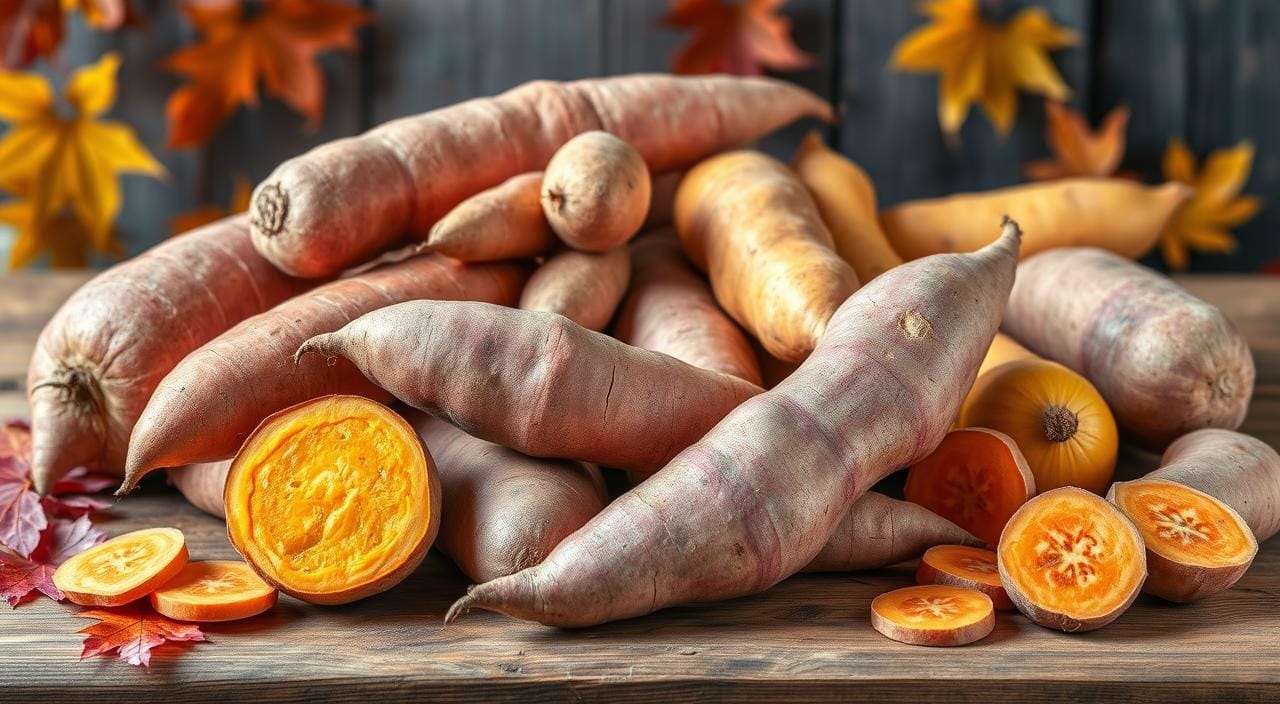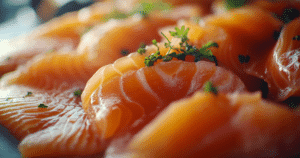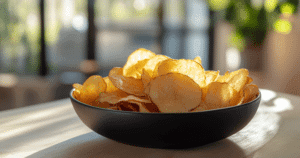Jump to:
Estimated reading time: 10 minutes
Table of contents
The mix-up between sweet potatoes and yams goes back a long time. It started with the slave trade, when enslaved Africans called sweet potatoes “nyami.” This was later changed to “yam” by the USDA in the 1930s. They did this to make a difference between the bright orange sweet potatoes from Puerto Rico and other sweet potatoes.
Today, most “yams” in the U.S. are actually sweet potatoes, not true yams. True yams are rare in American stores but are becoming more common.
Key Takeaways
- Sweet potatoes and yams are not the same – they belong to different botanical families.
- True yams have a distinct appearance with dark brown, bark-like skin and white or purple flesh, while sweet potatoes have smooth reddish skin and orange, white, or purple flesh.
- Sweet potatoes are generally sweeter and creamier in texture compared to the starchier and drier yams.
- Sweet potatoes contain more nutrients like vitamin A, vitamin C, fiber, and protein than yams.
- Most “yams” sold in the U.S. are actually sweet potato varieties, not true yams.
Introduction
Sweet potatoes and yams are two different root vegetables. They look, taste, and feel different. Knowing the difference is key for holiday meals and recipes.
The mix-up between sweet potatoes and yams started long ago. In the trans-Atlantic slave trade, yams were a main food for enslaved Africans. Later, as sweet potatoes became common in the U.S., “yam” started to mean a certain sweet potato type. This mistake still happens today.
We’ll look into the differences between sweet potatoes and candied yams. We’ll talk about their origins, tastes, nutrition, and uses in cooking. This knowledge will help you pick the right ingredient for your holiday dishes and make tasty, authentic recipes.
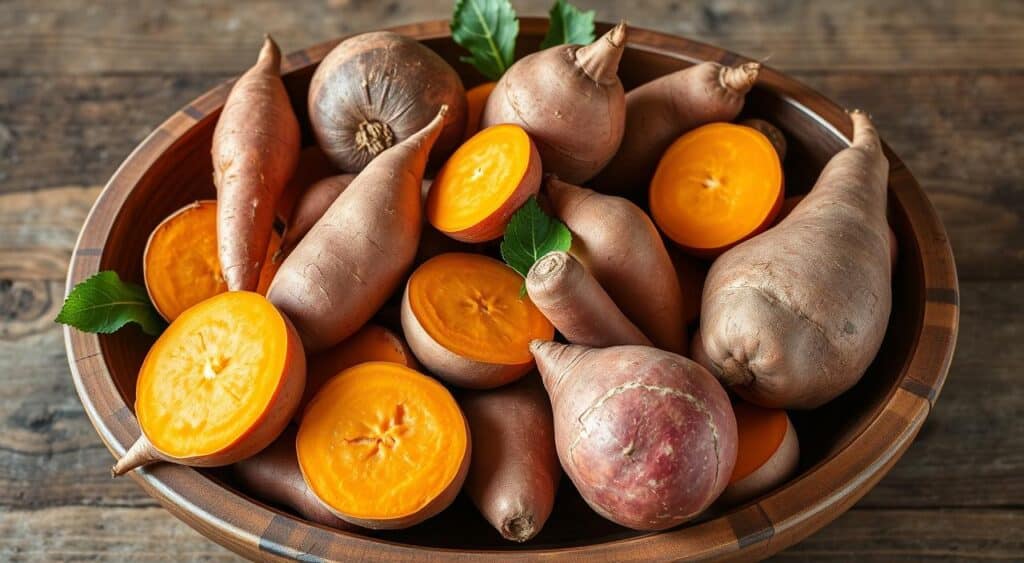
Sweet potatoes are known for their golden-orange color and soft texture. Yams are starchier. By learning about their differences, we appreciate their cultural and culinary richness.
Sweet Potatoes vs Candied Yams: Defining the Difference
Sweet potatoes and candied yams are often mixed up, but they’re not the same. They have different origins, tastes, and uses in cooking. Let’s look at what makes sweet potatoes and candied yams unique.
What Are Sweet Potatoes?
Sweet potatoes are roots from Central and South America. They come in orange, purple, and white and taste sweet and creamy. You can find them in dishes like sweet potato casserole and sweet potato fries.
What Are Candied Yams?
Candied yams aren’t really yams. They’re sweet potatoes cooked with sugar and syrup. This makes a sweet dish perfect for holidays.
Common Misconceptions Between Sweet Potatoes and Yams
People often mix up sweet potatoes and yams because of how “yam” is used in the U.S. But, true yams come from Asia, Africa, and the Caribbean. They’re starchier and taste less sweet than sweet potatoes.
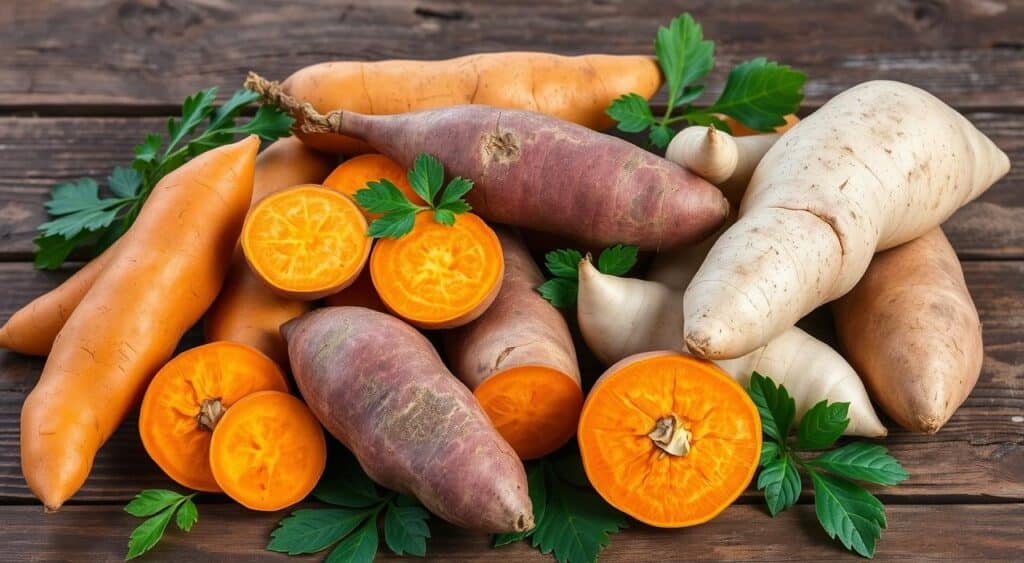
Many stores in North America call orange-fleshed sweet potatoes “yams.” But, the U.S. Department of Agriculture says they must also be labeled as sweet potatoes.
Key Differences Between Sweet Potatoes and Candied Yams
Sweet potatoes and candied yams may look alike, but they are very different. They have different tastes, textures, and nutrients. Knowing these differences is key when picking the right vegetable for your recipes.
Flavor Profile: Sweetness and Texture
Sweet potatoes taste naturally sweet and creamy. They become even sweeter when roasted or baked. True yams, however, are starchier and drier, with a more neutral taste.
Nutritional Differences
Sweet potatoes are packed with more nutrients than yams. They have more vitamins A and C, fiber, and antioxidants. This makes them a better choice for healthy meals and holiday dishes.
How They’re Used in Different Recipes
Sweet potatoes are great in sweet dishes like casseroles and pies. Yams, with their starchier taste, are better for savory dishes like roasting or mashing.
| Characteristic | Sweet Potatoes | Candied Yams |
|---|---|---|
| Flavor | Naturally sweet, creamy | Starchy, earthy |
| Texture | Soft, smooth | Drier, more fibrous |
| Nutritional Profile | High in vitamins A and C, fiber, antioxidants | Less nutrient-dense |
| Typical Preparations | Sweet dishes (casseroles, pies, gratins) | Savory dishes (roasted, mashed) |
Knowing the differences between sweet potatoes and candied yams helps in planning meals. Whether you want something sweet or savory, these vegetables offer many tasty options.
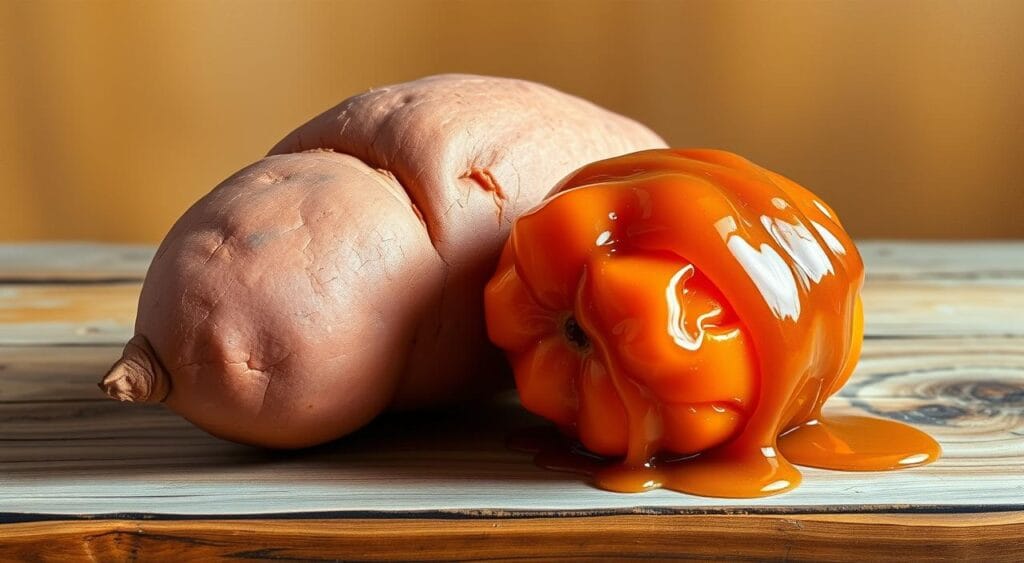
How to Prepare Sweet Potatoes vs Candied Yams
Sweet potatoes and candied yams are two unique dishes. They need different cooking methods to get their special tastes and textures. Knowing how to prepare these dishes can make your holiday meals even better.
Best Methods to Cook Sweet Potatoes
Sweet potatoes can be cooked in many ways to highlight their sweetness. Roasting is a favorite because it makes them creamy and tender. To roast, toss peeled and cubed sweet potatoes with olive oil, salt, and pepper. Bake at 400°F for 25-30 minutes until tender.
Baking whole sweet potatoes is another great method. It makes them sweet and fluffy inside. Just pierce them, place on a baking sheet, and bake at 400°F for 45-60 minutes until tender.
How to Make the Perfect Candied Yams
Candied yams mix sweet potatoes with sweeteners and spices. The secret is finding the right balance between the sweet potatoes’ natural sweetness and the glaze’s flavors.
Begin by peeling and slicing sweet potatoes into 1-inch rounds. In a baking dish, arrange the slices and mix with brown sugar, butter, vanilla, cinnamon, nutmeg, and salt. Bake at 375°F for 60-75 minutes, basting occasionally, until tender and caramelized.
Ingredient Differences: Spices, Sweeteners, and Additions
The main difference between sweet potatoes and candied yams is the spices and sweeteners. Sweet potatoes use simple seasonings like salt and pepper. Candied yams have a mix of spices like cinnamon, nutmeg, and ginger.
Sweet potato recipes often don’t add much sugar, letting the natural sweetness shine. Candied yams, however, have a sweet glaze made with brown sugar, maple syrup, or marshmallows. This glaze adds a rich, caramelized topping.
Sweet Potatoes vs Candied Yams for Different Occasions
Sweet potatoes and candied yams are both loved for different times and tastes. Candied yams are a top pick for Thanksgiving, while sweet potatoes are great all year as a flexible side dish.
Candied Yams for Holiday Feasts
They are a key part of Thanksgiving and Christmas. Their sweet taste and caramelized texture are perfect with turkey, ham, and more. Sweet potatoes, brown sugar, butter, and spices make a cozy holiday dish.
Sweet Potatoes for Everyday Meals
The sweet potatoes are great for many meals because they’re easy to make in many ways. They go well with chicken, pork, and more. They’re also good for those who want to eat healthier, adding more root vegetables to their diet.
Vegan and Gluten-Free Alternatives
For vegans or those who can’t eat gluten, sweet potatoes are a better choice than candied yams. They can be roasted, mashed, or used in veggie dishes. This makes them a healthy and safe side for many meals.
| Occasion | Sweet Potatoes | Candied Yams |
|---|---|---|
| Holidays | Versatile side dish | Classic Thanksgiving favorite |
| Everyday Meals | Pairs well with various proteins | Too rich and sweet for everyday |
| Dietary Restrictions | Suitable for vegan and gluten-free diets | Often contains dairy and may not be gluten-free |
Choosing sweet potatoes or candied yams can make any meal special. Both root vegetables add a delicious touch to your meals, whether it’s a holiday or just a regular day.
Common Mistakes When Using Sweet Potatoes and Candied Yams
When cooking with sweet potatoes and candied yams, many home chefs make mistakes. They often confuse one for the other or cook them wrong. It’s key to know the differences to get the right taste and texture in your dishes.
Mistaking Sweet Potatoes for Yams in Recipes
Many people mix up sweet potatoes and yams. But they are different veggies with their own tastes and cooking ways. Swapping them in a recipe can mess up the dish’s flavor and texture.
Over- or Under-cooking Yams and Sweet Potatoes
It’s vital to cook sweet potato recipes and yam recipes right. Overcooking makes them mushy, while undercooking makes them hard. Use the right cooking times and methods to get the best root vegetables for your dish.
Using the Wrong Ingredients for Each Dish
Another mistake is picking the wrong ingredients for sweet potatoes or candied yams. Wrong sweeteners, spices, or toppings can ruin the taste. Knowing the best ingredients and cooking ways for each holiday side dishes and thanksgiving dishes is crucial.
“Properly preparing sweet potatoes and yams is key to achieving the desired flavors and textures in your recipes. Avoiding these common mistakes will ensure your dishes are a hit at any gathering.”
By watching out for these mistakes, home cooks can make the most of sweet potatoes and candied yams. With the right techniques and ingredients, these root vegetables can be the highlight of any holiday side dishes or thanksgiving dishes.
Frequently Asked Questions: What’s the difference between sweet potatoes and candied yams?
Are candied yams actually made with yams?
In the U.S., candied yams are usually made with sweet potatoes, not true yams. True yams are starchy and white or purple in color, with a more neutral flavor, and are less common in American stores. Sweet potatoes are softer and naturally sweet, making them better suited for the candied preparation.
Do sweet potatoes and candied yams taste different?
Yes, plain sweet potatoes have a natural sweetness and earthy flavor, while candied yams (made from sweet potatoes) are sweeter and richer due to the addition of brown sugar, butter, and spices. Candied yams have a caramelized, dessert-like flavor.
Are candied yams healthy?
Candied yams are higher in sugar and calories due to the added brown sugar, butter, and sometimes marshmallows. Plain baked or roasted sweet potatoes are a healthier option, as they retain their natural nutrients without added sugar.
How are candied yams typically served?
Candied yams are a popular holiday side dish, often served alongside main courses like turkey or ham. They are particularly popular for Thanksgiving and Christmas meals, as their sweetness complements savory dishes.
Conclusion: Choosing the Right Dish for Your Meal
Sweet potatoes and candied yams are both tasty root vegetables. Knowing their differences is key to picking the right dish for your meal. Whether it’s for a holiday feast or a side dish all year, knowing how to use them is important.
Sweet potato recipes are great for a sweeter, moister dish. They’re full of vitamins A and C and are naturally sweet. Sweet potatoes are perfect for desserts, casseroles, and main dishes.
Yam recipes are better for a heartier, starchier texture. Yams are drier and more savory. They’re great roasted, mashed, or candied, often as a side to protein-rich dishes.
Both sweet potatoes and yams are great for any meal, from holiday sides to Thanksgiving dishes. Knowing their unique qualities helps you make delicious, satisfying dishes for your loved ones.
